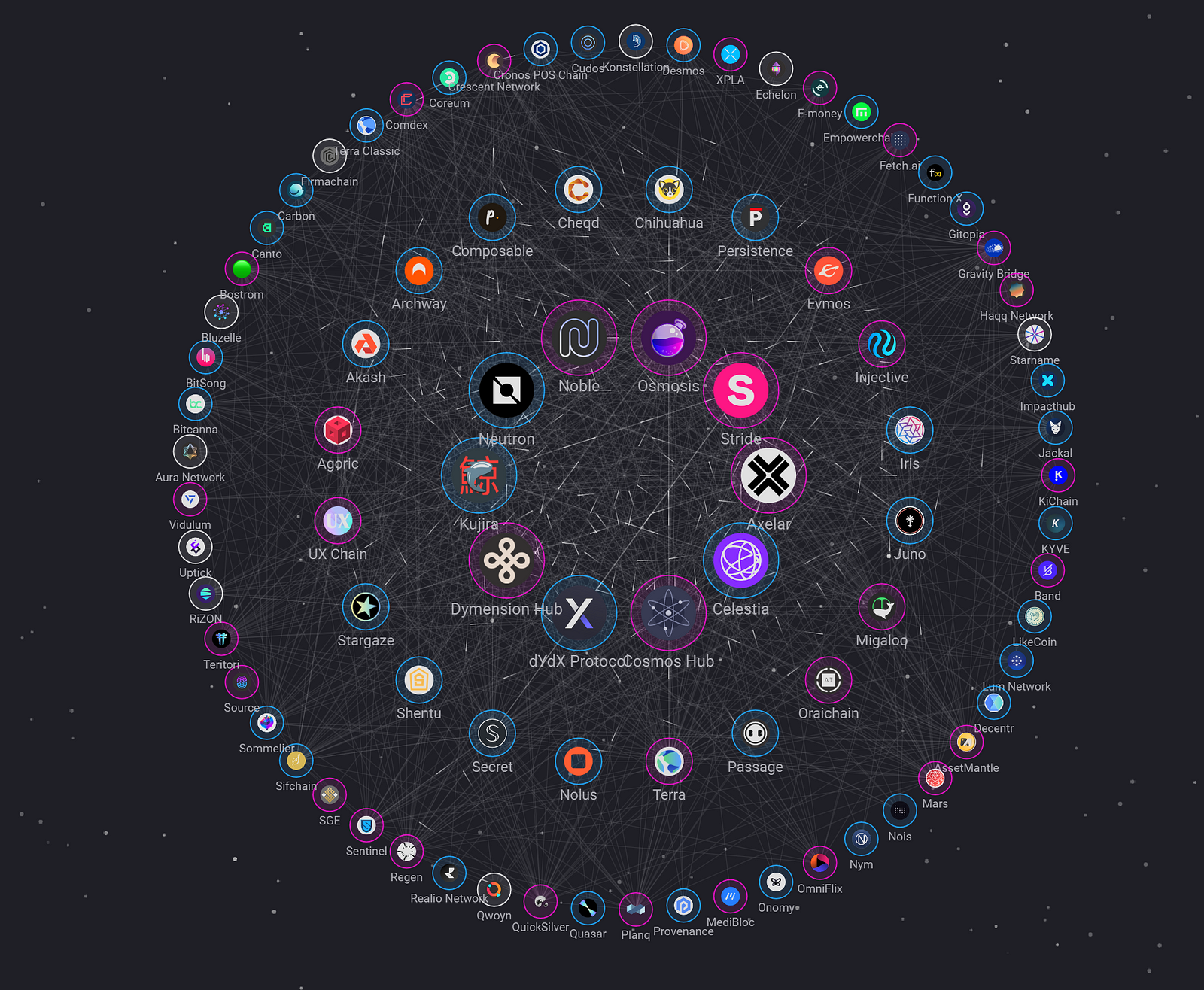
Blockchain interconnectivity is going to be a big focus in the years to come, well beyond just EVM-compatibility. I recently had a fascinating discussion on this topic with Interchain Foundations’ Managing Director Maria Gomez and Product Lead for Inter-Blockchain connectivity protocol Susannah Evans.
The Interchain Foundation have been instrumental in the building and development of the Cosmos Blockchain and they have created the idea of Internet of Blockchains.
I’ll drop the links to the conversation down below and I recommend you check it out.
🎧 Listen to the Podcast on Spotify | Apple Music | Youtube
I wanted to talk a bit more about Cosmos and the Idea of Internet of Blockchains as the more I think about it, the more it seems like the only way blockchain and cryptocurrency will evolve.
The Vision of Interchain
The vision behind Interchain and Cosmos is based on the belief that the future of blockchain technology lies not in a monolithic structure but in a diverse and interconnected network of blockchains.
This philosophy stems from the understanding that different communities and industries have unique needs that can be best served by specialized blockchains. However, for these individual blockchains to realize their full potential, they must be able to communicate and share information and assets efficiently.
This is where the Interchain Foundation’s work becomes pivotal, providing the tools and protocols necessary for creating a decentralized web of blockchains that can interact without central intermediaries.
Key Tools and Protocols
Inter-Blockchain Communication (IBC) Protocol
At the heart of Interchain’s and Cosmos’ toolkit is the IBC protocol, a standard for interoperability that enables secure and reliable communication between different blockchains.
By allowing data and assets to be transferred across chains, IBC opens up a world of possibilities for cross-chain applications and services, enhancing liquidity and enabling more complex decentralized applications (DApps) that can leverage the strengths of multiple blockchains.
What makes the IBC protocol unique, is the concept of Light Clients. Unlike bridges, which are known to have been exploited in the past, Light Clients operate by basically copying a very “light” version of Blockchain A’s state, on Blockchain B and vice-versa. This means that transactions and data transfers need to be verified on both state machines before they can take place. This is a massive bonus for security as well as scalability.
The IBC protocol works as a mailman. The transport layer is concerned with delivering the post, and the authentication layer makes sure that there is a delivery and return address on the message. The protocol is completely agnostic to the data sent, and it’s up to the receiving chain to acknowledge and do something with that data.
There are currently hundreds of interconnected chains on Cosmos, and the more the ecosystem grows, the more desirable the idea of being part of the internet of blockchains becomes.
Each application can talk to one or multiple applications or chains on the Cosmos network via the IBC protocol. There’s actually a pretty cool interactive map of how different apps and protocols interact with each other on cosmos here.

Cosmos SDK
The Cosmos SDK serves as the core framework for building blockchain applications with an emphasis on modularity. It allows users to build applications and even completely autonomous blockchains with their own governance and token, while ensuring that, if needed, they can communicate and interact with other chains and apps that are using the IBC protocol.
The genius behind this level of interconnectivity cannot be overstated. However, this is where Cosmos and Interchain are seeing some challenges. The tech has the ability to completely revolutionize blockchain and crypto forever.
No more unsecure bridges and siloed apps.
The challenge is that well established chains need to integrate the IBC protocol, which means making low-level changes to the way the chain handles data, in order to be able to transmit and receives messages from other chains and apps.
This is a non-trivial task and definitely one the biggest blocker to making chains like Bitcoin and Ethereum be IBC-compatible.
Interchain recognize this challenge and that’s why their main focus is adoption. With a product like Cosmos, the more applications are on your network, the more desirable it becomes for other chains and apps to start adopting your service.
It’s a bold vision, that takes time to accomplish, but I believe that the future of Blockchain and cryptocurrency is interconnected and I am hopeful that Cosmos will realize their vision.
🎧 Listen to the Podcast on Spotify | Apple Music | Youtube
Finally, if you’re into Algorithmic trading — check out algorithmic cryptocurrency trading platform Aesir! Aesir is a state-of-the-art trading platform that allows you to build complex crypto trading bots and maximise your gains.
Thank you for reading!
Enjoyed this article?
Sign up to the newsletter
You’ll receive more guides, articles and tools via e-mail. All free of course. But if you value this blog and its educational resources, you can subscribe to become a paid member for only $3 a month. This will keep the website open and free.
